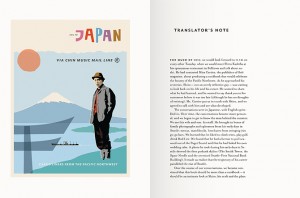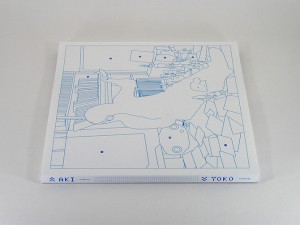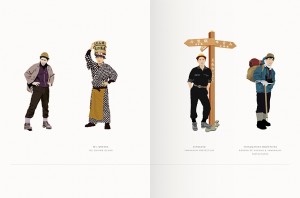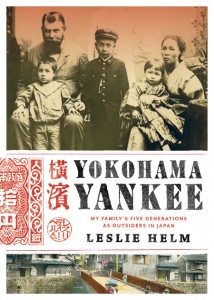JET Alum Artist Beat: Joshua Powell, Book Designer and Illustrator
******* JET Alum Artist Beat is a periodic feature organized by Jessica Sattell (Fukuoka-ken, 2007-2008) intending to share the wide scope of creative work that JET alumni are pursuing as artists, designers, and/or craftspeople. She is interested in interviewing and providing exposure for artists and arts professionals, and welcomes links to online portfolios, stores and businesses. Feel free to email Jessica at hello (dot) jessicasattell (at) gmail (dot) com with suggestions.
Joshua Powell (Saitama-ken, 2005-2007) is a Seattle-based book designer and illustrator. He has designed and produced a number of books for Japan-focused (and JET alum run) independent publisher Chin Music Press, including Shiro: Wit, Wisdom and Recipes from a Sushi Pioneer, which was a 2011 Washington State Book Award Finalist and won First Place in the Quality Paperback category at the 2012 New York Book Show. NPR called another title that he designed, Oh! a mystery of mono no aware, “a triumphant kick in the pants for anyone who doubts the future of paper-and-ink books.”
Josh graciously took the time to discuss his JET tenure and how his experiences in Japan influence his design sensibilities.

A spread from “Shiro: Wit, Wisdom and Recipes from a Sushi Pioneer” featuring one of Joshua’s original illustrations (image courtesy of Joshua Powell)
Tell us a little about your background. How did you decide to apply to JET and live in Japan?
From the ages of 9-17 I practiced traditional Japanese martial arts, training under a Japanese teacher who had relocated to my home state of Virginia. His two sons as well as other Japanese sensei would visit and teach at the dojo for extended periods of time.
When I was fifteen I was lucky enough to travel to Japan for a karate competition. I never really sought out Japanese culture. I just kind of fell into marital arts and by virtue of that, Japan became a pretty central part of my childhood and teenage years. The trip I took to Japan lasted two weeks, and after it was over I always had this feeling that I wanted to get back and live there – I wondered what it would be like to have things become more familiar, to feel comfortable there. It was a thought that just stuck in the back of my mind, and then when I found out about the JET Program years later, I didn’t think twice about applying.
Were there any experiences while you were on JET that you found particularly meaningful or memorable?
My two years on JET are very important to me – a consistently rewarding and meaningful time. There are many things that contributed to the experience being so great, but it really came down to the people I met and the places I visited while in Japan. I felt extremely lucky with the school I worked at – Omiya High School in Saitama-ken. I had great co-workers, some of whom I considered close friends, and so many enthusiastic and positive students. Outside of work I had some really great friends, other JETs as well as Japanese friends who I mainly met while traveling. There were so many opportunities to get out and explore the country. Unlike many JETs, I only left the country once during my two years. I almost exclusively spent my time off exploring Japan. Coming from the U.S., the ability and ease with which I could explore the country never ceased to amaze me – just hop on a train and you’re off on a new adventure.
One of the things that I came away from Japan with was the knowledge that you don’t need a lot of things to be happy. You can live in a tiny apartment and have few material possessions (no point in buying a lot of stuff when you aren’t staying somewhere permanently), but as long as there are good people in your life and you’re able to get out and experience new things, life can be very fulfilling.
As you mention in your interview with One A Day, you’re trained in printmaking. Has that influenced your work as a book designer?

Photograph highlighting the design of “Otaku Spaces” with book jacket removed (image courtesy of Joshua Powell)
Yes. I’m mostly self-taught when it comes to design, so of course I’m building off of the visual language I learned through making art, and particularly printmaking. And of course bookmaking is a form of printmaking – making an edition of ink on paper objects. So naturally, my enthusiasm for the physical book is greatly influenced by my background in printmaking. I’ve always worked with commercial printers – none of which were in Seattle. So in a way that’s very odd, that I’m giving up the actual printing aspect of the whole process to someone else. Nonetheless, since I’m not only doing the design but also handling the production aspect of the process (preparing files, choosing papers, communicating with the printer), I still have a hand in it. If I were to print the books myself or to work closely with a local printer, that would be the icing on the cake.
You’ve used the term “slow books,” like “slow food” or “slow travel,” to describe how people can engage with reading and enjoying books. Could you explain that concept further?
I guess what I’m getting at is trying to retain the enjoyment of long-form reading, and of experiencing a sort of atmosphere and extended connection with the text and design. An experience that is drawn out and prolonged over time as well as something that comes from a physical object that you would want to keep and hold onto, returning to it months or years later.
Do you have a design philosophy?

Joshua’s original illustrations as part of a visual timeline of Shiro Kashiba’s life, from “Shiro: Wit, Wisdom and Recipes from a Sushi Pioneer” (image courtesy of Joshua Powell)
In terms of book design, it’s about making sure the book is packaged in a way that honors and builds upon the quality of the content – giving a good impression right off the bat. As a reader, it’s hard for me to be completely excited about a piece of writing if it’s packaged in a poorly designed book or magazine. On the other hand, if it is well designed and well produced, it gives not only a sense of atmosphere to the content, but it gives the impression that the stories or information contained within are important enough that every aspect of the project was given the utmost attention and effort.
In the same way, if I’m watching a movie and the cinematography is subpar, that detracts from the overall experience. Conversely, if the opening titles (perhaps something some viewers might consider a trivial detail) have great typography and an interesting concept, then that just adds so much. Basically, when I begin a project, read through it and start to get excited about the content, then I’m thinking to myself, “Yeah, this is so great… now how do I convey how great this is to the reader before they even begin reading?”
What’s the most rewarding project that you’ve worked on?
Probably working on Shiro Kashiba’s memoir and cookbook, Shiro: Wit, Wisdom and Recipes from a Sushi Pioneer. Simply having the author here in Seattle made a huge difference. Also, to have the author be a renowned chef and to have this physical space (his restaurant, Shiro’s) to go to and speak with him, or to take photographs or just experience him in his “natural environment” made a huge difference. Learning more about his art of making sushi and other Japanese cuisine was rewarding. Coincidentally, the film Jiro Dreams of Sushi came out shortly after the book was released. Shiro apprenticed under Jiro Ono, and in the book I included these original photographs of Jiro and Shiro at Haneda airport, and of the two of them hiking in the mountains outside of Tokyo, and a matchbox from Jiro’s restaurant. So it was fun to have something I worked on feel connected with this film that had reached a much wider audience.

Cover of “Yokohama Yankee: My Family’s Five Generations as Outsiders in Japan” (image courtesy of Joshua Powell)
It was also a project where I really felt like I was contributing content to the project, and not just packaging someone else’s content. I was creating original illustrations and infographics, going to libraries and finding historic photos in their archives, and finding ephemera from 1960s Seattle at antique shops. On top of that, it combined my love of Japan, where I had lived for two years, and my love for my new home of Seattle.
What are you working on right now?
I’m putting the final touches on Leslie Helm’s book, Yokohama Yankee: My Family’s Five Generations as Outsiders in Japan (which comes out in March from Chin Music Press). It’s a fascinating account of his family’s five generations as mixed race inhabitants of Yokohama, as well as the story of his own adoption of two Japanese children. His family’s story is a dramatic one that’s linked with so many major historical events: the modernization of Japan, the two World Wars, the 1923 Kanto Earthquake, and the distrust and discrimination against outsiders in both Japan and the United States. Leslie has a large collection of historic family photos and other ephemera, and it’s always great to be handed such a treasure trove of visual material to work with.
After that, I’m hoping to work on a long term project relating to my love of hiking. I’m planning for a long distance hike of the Pacific Crest Trail, which runs for 2600 miles from the Mexican border to the Canadian border (along the West Coast). I think it’s an experience that would lend itself nicely to a design-driven book – a combination of journals, anecdotes from trail life, maps, illustrations and infographics related to the experience. It seems like the perfect opportunity to put together a book where I’m providing all of the content as well as handling the design and production.
To learn more about Joshua and his work, visit his online portfolio.


Comments are closed.